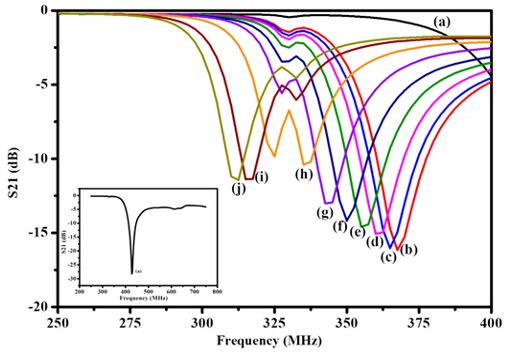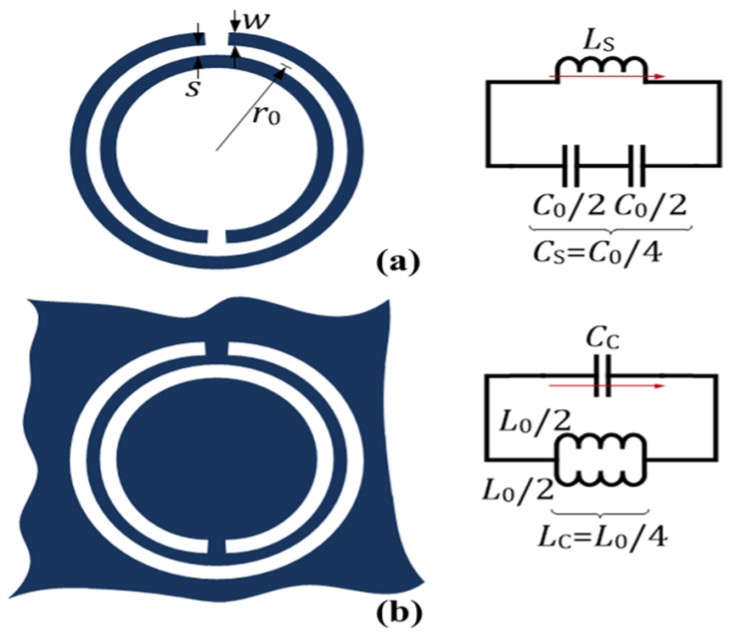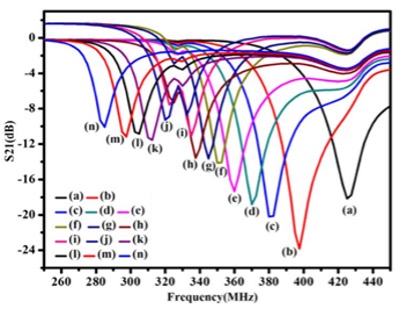| Apr 07, 2022 | |
Combination of engineered resonators and nanotechnology for sensing hazardous environments |
|
| (Nanowerk Spotlight) Metamaterials (MMs) are those materials whose properties are mainly based on their design and structure, rather than the actual materials used to realize them [1]. Sensors based on MMs-based structures are becoming increasingly popular due to their benefits like high sensitivity, high quality factor, label free detection, and real-time measurements [2]. | |
| Instead of using an array of structures, MMs-inspired structures use a single unit cell which have very small size, simple geometry, and easy fabrication method. These are engineered resonators. | |
| Such structures are cost effective and have been reported to show excellent sensing capabilities [3]. These can include chemical sensing [4]–[10], gas sensing [11], [12][13], and biological sensing applications [14]–[20]. They also show structural health monitoring such as for crack detection [21]–[25], angle and position detection [26]–[29], and strain measurement [30], [31]. | |
| These sensors work on the concept of resonance frequency shift, which is as a function of change in their sensing environment, and hence they are also known as resonance-based sensors. They work on the concept of change in dielectric constant as a result of variation in surrounding environment parameters and thus they can be used as an efficient chemical sensing tool [32]. | |
| Several biosensors based on such unit-cell resonators have been reported previously, which are simple and feasible for direct molecule detection [33]. | |
| Usually, biomaterials are in liquid form with water as their base. They show high values of permittivity [34]. Such biosensors can be used for sensing of biomaterials both in liquid state and in gaseous form using a thin layer of carbon nanotubes (CNTs) [35]. | |
| Resonance-based sensors can be used as an advanced tool for gas sensing [13], [36] as they show several advantages as compared to conventional gas sensors like metal-oxide semiconductor (MOS) and electro-chemical gas sensors [11]. They can work at lower temperatures and are less sensitive to variation in temperatures. | |
| With the introduction of an additional layer over the sensor, the selectivity of these sensors can also be improved. Although there are several categories of reported sensors based on MMs, we will be focussing mainly on split ring resonators (SRR) and complementary SRRs (CSRRs) structures used in several sensing applications. | |
| In the most general form, a MM-based sensor or a resonant frequency-based sensor is fabricated by sandwiching a dielectric material in between a conducting layer and a transmission line. The conducting layer is etched from one side of the substrate clad (which works as dielectric) and the other surface is patterned with antenna-like structure, which then contributes to the resonant frequency signal, when a radio-frequency signal is applied to this structure via a waveguide in a given range of frequencies. | |
| Proper selection of material and the etching of the structures onto it decides if the device is sensitive to magnetic field, electric field or both, and it can also determine the resonant frequency of the device. | |
 |
|
| Figure 1: Experimental S21 response of CSRR as a function of SO2 gas concentrations (a) bare CSRR, which is enlarged in the inset; (b) 0 ppm; (c) 9.912 ppm; (d) 29.75 ppm; (e) 49.59 ppm; (f) 99.19 ppm; (g) 148.78 ppm; (h) 198.38 ppm; (i) 247.97 ppm; (j) 297.58 ppm. (Reprinted with permission from Elsevier Publishers, https://doi.org/10.1016/j.sna.2021.112898) | |
| These resonator structures can be sub-divided into two categories – SRRs and CSRRs. SRRs consist of a conducting structure in the form of a ring or square shape over a dielectric substrate as shown in Figure 1(a) (along with its electrical equivalent circuit). | |
| This structure has a gap or slit present at one of the places along the structure. This structure is excited using a transmission line running parallel to the structure such that the magnetic field is directed perpendicular to the conducting plane [34]. This time varying magnetic field results in the formation of current in the ring structure [37]. | |
| CSRR structures are very similar to that of SRRs, except that they have a ring etched along the surface of the dielectric surface as shown in Figure 1(b) (along with its electrical equivalent circuit). A micro-strip line used for excitation is present in very close proximity or in line with the resonance structure (separated by a dielectric). Excitation using the micro-strip line results in electromagnetic field generation along the substrate which in turn induces current loops in the ring. As a result of distributed capacitance along the rings, the induced current loops get trapped along the concentric rings [38]. This results in the desired resonance of the MM structure. | |
| Functionalization using nanoparticles: CSRRs sensor beds, if functionalised using any nanomaterial, can enhance their sensitivity. This has been observed earlier. We take two examples here to see how the effect enhances with a combination of RF technology with nanotechnology. | |
| Iron oxide (Fe3O4) NPs: Fe3O4 nanoparticles are one type of materials, which have high sensitivity towards hazardous chemicals such as chemicals of NO2 base. A ferrofluid solution of such particles if it's purged with NO2 gas and then subjected to the CSRR sensor, shows excellent sensitivity and selectivity towards this hazardous gas. | |
| Wide band-gap semiconductor NPs: Wide band gap semiconductors are well known as resistive sensors for reducing and oxidising gases. These are synthesised in various ways, and all the processes are well documented. Titanium dioxide (TiO2) NP is one such example, which has been synthesised and suspended in aqueous medium, in which hazardous gas is purged. Towards SO2 gas, the sensor shows excellent sensitivity and selectivity. | |
| Detailed chemical analysis does justify the exclusive selectivity towards sulphur-based hazardous moieties of TiO2 NPs. | |
A Few Salient Results |
|
| From the studies done by our research group, we share a few results here to exhibit the sensor responses. For each concentration, Fe3O4 nanoparticulate solution purged with NO2 the response was studied. | |
 |
|
| Figure 2: (a) Split ring resonator circuit with its electrical equivalent circuit, (b) Complimentary split ring resonator with its electrical equivalent circuit. | |
| Figure 2 shows the CSRR response when exposure to varying concentrations (0–106 ppm) of NO2 gas purged into Fe3O4 nanoparticles. As the concentration of NO2 increases, the resonance frequency reduces. Additional signature of NO2 moieties is observed at 300 MHz. The sensor shows a sensitivity of 0.2 MHz/ppm. | |
| On similar lines, Figure 3 shows the S21 response of TiO2 NPs functionalised sensor for SO2 detection. As the SO2 gas concentration increases, the resonance frequency decreases. An additional peak is again evolved in this case at 330 MHz. This added signature is the contribution from the SO2 purged – TiO2 NPs. The sensor showed a sensitivity of 17.3 KHz/ppm. | |
 |
|
| Figure 3: Experimental S21 response of CSRR to NO2 gas; 0 ppm (a), 0.88 ppm (b), 1.76 ppm (c), 2.64 ppm (d), 3.53 ppm (e), 4.41 ppm (f), 5.29 ppm (g), 10.59 ppm (h), 21.18 ppm (i), 42.37 ppm (j), 63.56 ppm (k), 74.16 ppm (l), 95.35 ppm (m), 105.94 ppm (n) (Source: Taken from Ref. 36, with permissions obtained from Springer Nature, https://doi.org/10.1007/s00339-020-03905-8 ) | |
Conclusion |
|
| Resonators, typically antenna-like structures with an appropriate waveguide, serve as excellent sensors due to their electric field in the vicinity, when they are excited by RF frequency signals. They are highly sensitive to the dielectric medium in their vicinity, which can be harnessed for sensing chemicals, electric/magnetic field and so on. | |
| If these structures are further functionalised using nanoparticles, their surfaces become much more sensitive and selective to proper moieties. Therefore, a combination of miniaturized electronics, nanomaterials and fine chemistry between the sensor and the sensing moieties, makes this technology extremely popular for low ppm sensing of hazardous environments. | |
| This is one of the classic examples to prove that an interdisciplinary approach towards research can unfold extremely useful technologies to solve challenging problems | |
References |
|
| [1] K. Parveen, “Metamaterials: Types, applications, development, and future scope,” Int. J. Adv. Res., vol. 4, no. 3, pp. 2325–2327, 2018, [Online]. Available: www.IJARIIT.com. | |
| [2] T. Chen, S. Li, and H. Sun, “Metamaterials application in sensing,” Sensors, vol. 12, no. 3, pp. 2742–2765, 2012, doi: 10.3390/s120302742. | |
| [3] A. Tamer et al., “Transmission Line Integrated Metamaterial Based Liquid Sensor,” J. Electrochem. Soc., vol. 165, no. 7, pp. B251–B257, 2018, doi: 10.1149/2.0191807jes. | |
| [4] A. Sadeqi, S. Sonkusale, and H. Rezaei Nejad, “LOW-COST METAMATERIAL-ON-PAPER Nano Lab , Department of Electrical and Computer Engineering ,” Transducers, IEEE, vol. 25, no. 14, pp. 1437–1440, 2017, doi: 10.1364/OE.25.016092. | |
| [5] A. Salim, S. Ghosh, and S. Lim, “Low-cost and lightweight 3D-printed split-ring resonator for chemical sensing applications,” Sensors (Switzerland), vol. 18, no. 9, 2018, doi: 10.3390/s18093049. | |
| [6] H. K. Kim, D. Lee, and S. Lim, “A fluidically tunable metasurface absorber for flexible large-scale wireless ethanol sensor applications,” Sensors (Switzerland), vol. 16, no. 8, 2016, doi: 10.3390/s16081246. | |
| [7] M. U. Memon and S. Lim, “Microfluidic high-Q circular substrate-integrated waveguide (SIW) cavity for radio frequency (RF) chemical liquid sensing,” Sensors (Switzerland), vol. 18, no. 1, 2018, doi: 10.3390/s18010143. | |
| [8] M. Yoo, H. K. Kim, and S. Lim, “Electromagnetic-based ethanol chemical sensor using metamaterial absorber,” Sensors Actuators, B Chem., vol. 222, pp. 173–180, 2016, doi: 10.1016/j.snb.2015.08.074. | |
| [9] V. Rawat, R. Kitture, D. Kumari, H. Rajesh, S. Banerjee, and S. N. Kale, “Hazardous materials sensing: An electrical metamaterial approach,” J. Magn. Magn. Mater., vol. 415, pp. 77–81, 2016, doi: 10.1016/j.jmmm.2015.11.023. | |
| [10] S. RoyChoudhury, V. Rawat, A. H. Jalal, S. N. Kale, and S. Bhansali, “Recent advances in metamaterial split-ring-resonator circuits as biosensors and therapeutic agents,” Biosens. Bioelectron., vol. 86, pp. 595–608, 2016, doi: 10.1016/j.bios.2016.07.020. | |
| [11] G. Barochi, J. Rossignol, and M. Bouvet, “Development of microwave gas sensors,” Sensors Actuators, B Chem., vol. 157, no. 2, pp. 374–379, 2011, doi: 10.1016/j.snb.2011.04.059. | |
| [12] M. A. Ali, M. M. C. Cheng, J. C. M. Chen, and C. T. M. Wu, “Microwave Gas Sensor based on Graphene-loaded Substrate Integrated Waveguide Cavity Resonator,” IEEE MTT-S Int. Microw. Symp. Dig., vol. 2016-Augus, no. Cvd, pp. 4–7, 2016, doi: 10.1109/MWSYM.2016.7540295. | |
| [13] V. Rawat, S. Joglekar, B. Bhagat, and S. N. Kale, “Nanomaterial-functionalized-metamaterial-inspired resonators for ultra-sensitive and selective H 2 S Sensing,” Proc. IEEE Sensors, vol. 2018-Janua, no. March 2019, pp. 1–4, 2018, doi: 10.1109/ICSENS.2018.8630283. | |
| [14] Z. Ramsaroop, S. Rocke, N. Gayapersad, and J. Persad, “CSRR - Based Microwave Sensor for Measurement of Blood Creatinine Concentrations Levels,” in Proceedings of the 2016 COMSOL Conference, 2016, pp. 3–8. | |
| [15] Y. Li et al., “Four resonators based high sensitive terahertz metamaterial biosensor used for measuring concentration of protein,” J. Phys. D. Appl. Phys., vol. 52, no. 9, 2019, doi: 10.1088/1361-6463/aaf7e9. | |
| [16] J. Kim, A. Babajanyan, A. Hovsepyan, K. Lee, and B. Friedman, “Microwave dielectric resonator biosensor for aqueous glucose solution,” Rev. Sci. Instrum., vol. 79, no. 8, pp. 1–4, 2008, doi: 10.1063/1.2968115. | |
| [17] M. Hofmann, G. Fischer, R. Weigel, and D. Kissinger, “Microwave-based noninvasive concentration measurements for biomedical applications,” IEEE Trans. Microw. Theory Tech., vol. 61, no. 5, pp. 2195–2204, 2013, doi: 10.1109/TMTT.2013.2250516. | |
| [18] H. J. Lee, J. H. Lee, S. Choi, I. S. Jang, J. S. Choi, and H. Il Jung, “Asymmetric split-ring resonator-based biosensor for detection of label-free stress biomarkers,” Appl. Phys. Lett., vol. 103, no. 5, 2013, doi: 10.1063/1.4816440. | |
| [19] C. Dalmay, A. Pothier, P. Blondy, F. Lalloue, and M. O. Jauberteau, “Label free biosensors for human cell characterization using radio and microwave frequencies,” IEEE MTT-S Int. Microw. Symp. Dig., pp. 911–914, 2008, doi: 10.1109/MWSYM.2008.4632981. | |
| [20] H. Torun, F. Cagri Top, G. Dundar, and A. D. Yalcinkaya, “An antenna-coupled split-ring resonator for biosensing,” J. Appl. Phys., vol. 116, no. 12, 2014, doi: 10.1063/1.4896261. | |
| [21] A. Ali, B. Hu, and O. Ramahi, “Intelligent detection of cracks in metallic surfaces using a waveguide sensor loaded with metamaterial elements,” Sensors (Switzerland), vol. 15, no. 5, pp. 11402–11416, 2015, doi: 10.3390/s150511402. | |
| [22] Rajni, A. Kaur, and A. Marwaha, “Complementary split ring resonator based sensor for crack detection,” Int. J. Electr. Comput. Eng., vol. 5, no. 5, pp. 1012–1017, 2015, doi: 10.11591/ijece.v5i5.pp1012-1017. | |
| [23] B. Hu, Z. Ren, M. S. Boybay, and O. M. Ramahi, “Waveguide probe loaded with split-ring resonators for crack detection in metallic surfaces,” IEEE Trans. Microw. Theory Tech., vol. 62, no. 4, pp. 871–878, 2014, doi: 10.1109/TMTT.2014.2309897. | |
| [24] C. Y. Yeh and R. Zoughi, “A Novel Microwave Method for Detection of Long Surface Cracks in Metals,” IEEE Trans. Instrum. Meas., vol. 43, no. 5, pp. 719–725, 1994, doi: 10.1109/19.328896. | |
| [25] A. McClanahan, S. Kharkovsky, A. R. Maxon, R. Zoughi, and D. D. Palmer, “Depth evaluation of shallow surface cracks in metals using rectangular waveguides at millimeter-wave frequencies,” IEEE Trans. Instrum. Meas., vol. 59, no. 6, pp. 1693–1704, 2010, doi: 10.1109/TIM.2009.2027780. | |
| [26] A. K. Horestani, C. Fumeaux, S. F. Al-Sarawi, and D. Abbott, “Displacement sensor based on diamond-shaped tapered split ring resonator,” IEEE Sens. J., vol. 13, no. 4, pp. 1153–1160, 2013, doi: 10.1109/JSEN.2012.2231065. | |
| [27] A. Ebrahimi, W. Withayachumnankul, S. F. Al-Sarawi, and D. Abbott, “Metamaterial-inspired rotation sensor with wide dynamic range,” IEEE Sens. J., vol. 14, no. 8, pp. 2609–2614, 2014, doi: 10.1109/JSEN.2014.2313625. | |
| [28]J. Mata-Contreras, C. Herrojo, and F. Martin, “Application of Split Ring Resonator (SRR) Loaded Transmission Lines to the Design of Angular Displacement and Velocity Sensors for Space Applications,” IEEE Trans. Microw. Theory Tech., vol. 65, no. 11, pp. 4450–4460, 2017, doi: 10.1109/TMTT.2017.2693981. | |
| [29] J. Naqui, J. Coromina, A. Karami-Horestani, C. Fumeaux, and F. Martín, “Angular displacement and velocity sensors based on coplanar waveguides (CPWs) loaded with S-shaped split ring resonators (S-SRR),” Sensors (Switzerland), vol. 15, no. 5, pp. 9628–9650, 2015, doi: 10.3390/s150509628. | |
| [30] O. Altintas, M. Aksoy, O. Akgol, E. Unal, M. Karaaslan, and C. Sabah, “Fluid, Strain and Rotation Sensing Applications by Using Metamaterial Based Sensor,” J. Electrochem. Soc., vol. 164, no. 12, pp. B567–B573, 2017, doi: 10.1149/2.1971712jes. | |
| [31] R. Melik, E. Unal, N. K. Perkgoz, C. Puttlitz, and H. V. Demir, “Metamaterial-based wireless strain sensors,” Appl. Phys. Lett., vol. 95, no. 1, 2009, doi: 10.1063/1.3162336. | |
| [32] E. Ekmekci, U. Kose, A. Cinar, O. Ertan, and Z. Ekmekci, “The use of metamaterial type double-sided resonator structures in humidity and concentration sensing applications,” Sensors Actuators, A Phys., vol. 297, p. 111559, 2019, doi: 10.1016/j.sna.2019.111559. | |
| [33] H. J. Lee et al., “A planar split-ring resonator-based microwave biosensor for label-free detection of biomolecules,” Sensors Actuators, B Chem., vol. 169, pp. 26–31, 2012, doi: 10.1016/j.snb.2012.01.044. | |
| [34] A. Verma, S. Bhushan, P. N. Tripathi, M. Goswami, and B. R. Singh, “A defected ground split ring resonator for an ultra-fast, selective sensing of glucose content in blood plasma,” J. Electromagn. Waves Appl., vol. 31, no. 10, pp. 1049–1061, 2017, doi: 10.1080/09205071.2017.1325011. | |
| [35] K. B. Yu, S. G. Ogourtsov, V. G. Belenky, A. B. Maslenikov, and A. S. Omar, “Accurate microwave resonant method for complex permittivity measurements of liquids,” IEEE Trans. Microw. Theory Tech., vol. 48, no. 11, pp. 2159–2164, 2000, doi: 10.1109/22.884209. | |
| [36] V. Kale, C. Chavan, D. Sable, K. G. Girija, S. Banerjee, and S. N. Kale, “Fe3O4-mediated dielectric sensor using metamaterial-inspired resonators for the NO2 sensing,” Appl. Phys. A Mater. Sci. Process., vol. 126, no. 9, pp. 1–8, 2020, doi: 10.1007/s00339-020-03905-8. | |
| [37] H. J. Lee, H. S. Lee, K. H. Yoo, and J. G. Yook, “DNA sensing using split-ring resonator alone at microwave regime,” J. Appl. Phys., vol. 108, no. 1, pp. 0–6, 2010, doi: 10.1063/1.3459877. | |
| [38] A. M. Albishi, M. S. Boybay, and O. M. Ramahi, “Complementary split-ring resonator for crack detection in metallic surfaces,” IEEE Microw. Wirel. Components Lett., vol. 22, no. 6, pp. 330–332, 2012, doi: 10.1109/LMWC.2012.2197384. | |
| By Vivek Kale, Rajat Srivastava and Sangeeta Kale*, Department of Applied Physics, Defence Institute of Advanced Technology (DIAT), Pune, India *email: [email protected] | |
|
Become a Spotlight guest author! Join our large and growing group of guest contributors. Have you just published a scientific paper or have other exciting developments to share with the nanotechnology community? Here is how to publish on nanowerk.com. |
|
